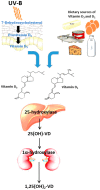Vitamin D Deficiency in Chronic Kidney Disease: Recent Evidence and Controversies
- PMID: 30126163
- PMCID: PMC6121405
- DOI: 10.3390/ijerph15081773
Vitamin D Deficiency in Chronic Kidney Disease: Recent Evidence and Controversies
Abstract
Vitamin D (VD) is a pro-hormone essential for life in higher animals. It is present in few types of foods and is produced endogenously in the skin by a photochemical reaction. The final step of VD activation occurs in the kidneys involving a second hydroxylation reaction to generate the biologically active metabolite 1,25(OH)₂-VD. Extrarenal 1α-hydroxylation has also been described to have an important role in autocrine and paracrine signaling. Vitamin D deficiency (VDD) has been in the spotlight as a major public healthcare issue with an estimated prevalence of more than a billion people worldwide. Among individuals with chronic kidney disease (CKD), VDD prevalence has been reported to be as high as 80%. Classically, VD plays a pivotal role in calcium and phosphorus homeostasis. Nevertheless, there is a growing body of evidence supporting the importance of VD in many vital non-skeletal biological processes such as endothelial function, renin-angiotensin-aldosterone system modulation, redox balance and innate and adaptive immunity. In individuals with CKD, VDD has been associated with albuminuria, faster progression of kidney disease and increased all-cause mortality. Recent guidelines support VD supplementation in CKD based on extrapolation from cohorts conducted in the general population. In this review, we discuss new insights on the multifactorial pathophysiology of VDD in CKD as well as how it may negatively modulate different organs and systems. We also critically review the latest evidence and controversies of VD monitoring and supplementation in CKD patients.
Keywords: Vitamin D; Vitamin D deficiency; chronic kidney disease; proteinuria.
Conflict of interest statement
The authors declare no conflict of interest.
Figures



References
-
- Vitamin D. The British Dietetic Association (BDA) Food Fact Sheet. [(accessed on 17 July 2018)]; Available online: https://www.bda.uk.com/foodfacts/VitaminD.pdf.
Publication types
MeSH terms
Substances
LinkOut - more resources
Full Text Sources
Other Literature Sources
Medical

